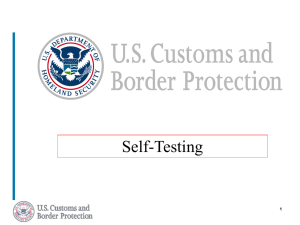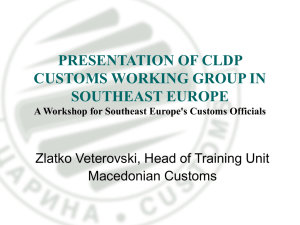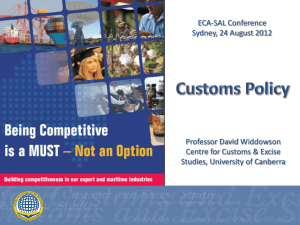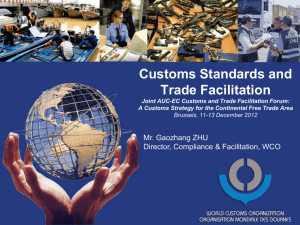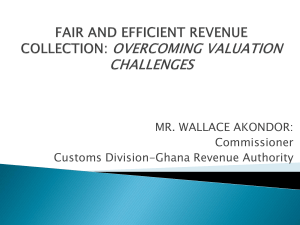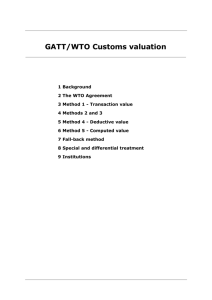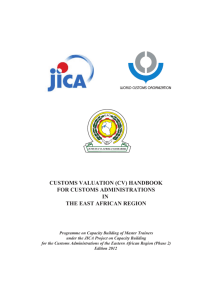Customs Valuation Introduction
advertisement
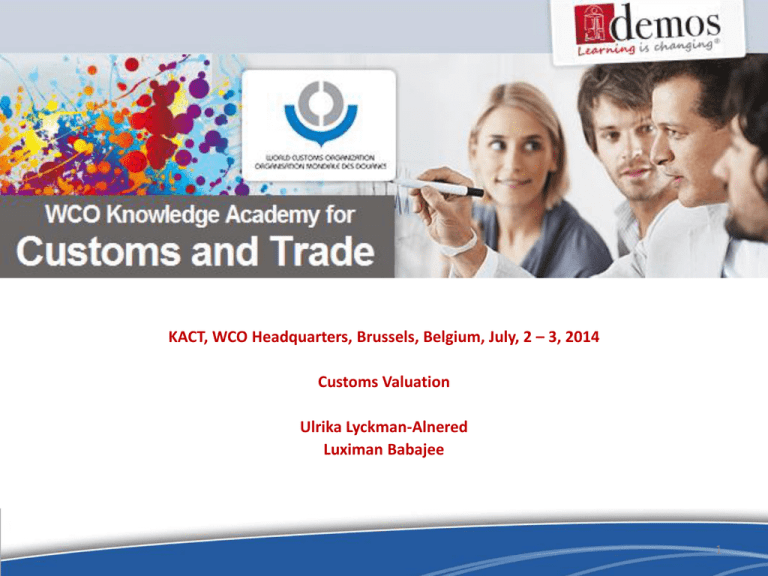
KACT, WCO Headquarters, Brussels, Belgium, July, 2 – 3, 2014 Customs Valuation Ulrika Lyckman-Alnered Luximan Babajee 1 Introductions 3 Master Class in Customs Valuation Sessions I-VI Day 1 I Introduction to the programme and an introduction to WCO II General introduction to Customs Valuation III Exercise on customs valuation and its basic components IV WTO and its work; Dispute Settlement Body Day 2 V Compulsory adjustments, optional adjustments, assists & royalties, successive sale and freight terms. VI Exercise on customs valuation, summary and closing remarks 4 4 Session I Introduction to the World Customs Organisation WCO; Luximan Babajee Session II General Introduction to Customs Valuation Demos: Ulrika Lyckman-Alnered WCO: Luximan Babajee Value? Your definition? “ worth; desirability”; “purchasing power; equivalent of a thing which may be substituted or exchanged for a thing ” (Concise Oxford Dictionary) 7 7 Value Value Purchase Importer Goods Imported Customs Value Declaration Agreement on implementation of Article VII of the GATT (1994) Customs Value of Imported Goods is: “ the value of goods for the purpose of levying ad valorem duties of customs ” Types of Customs Duties AD VALOREM - % OF CUSTOMS VALUE SPECIFIC/FIXED - COST PER UNIT OF MEASUREMENT e.g. , 1 c.u. per kg COMPOSITE - AD VALOREM & SPECIFIC/FIXED LESSON 2: General Introductory Commentary PART I PART II PART III PART IV ANNEX I ANNEX II ANNEX III - Rules on customs valuation (Articles 1-17) Administration, consultations & dispute settlement (Articles 18 & 19) Special & differential treatment (Article 20) Final provisions (Articles 21-24) Interpretative Notes: General Note / Notes to Articles Technical Committee on customs valuation Derogations for developing countries Methods of Valuation Article 1 Article 2 Article 3 Article 4 Article 5 Article 6 Article 7 Article 8 Transaction Value Transaction Value of Identical Goods Transaction Value of Similar Goods Application of Articles 5 & 6 Deductive Method Computed Value Method Fallback Method Additional elements to be added to the transaction value Articles 9-17 Article 9 Article 10 Article 11 Article 12 Article 13 Article 14 Article 15 Article 16 Article 17 Currency conversion Confidentiality Importers right to appeal without penalty. Obligation to publish laws. Obligation to provide a guarantee system. Refers to Annex I Notes, Annexes II and III. Defines certain words and terms. Right of importers to written explanation. Rights of customs administrations Articles 18-24 Article 18 Article 19 Article 20 Article 21 Article 22 Article 23 Article 24 WTO Valuation Committee and WCO Technical Committee on Customs Valuation. Consultations and disputes. Special provisions available to developing countries. Reservations. Obligations regarding national legislation. Review of implementation and operation of the Agreement by WTO Valuation Committee. Responsibilities of WTO and WCO Secretariats LESSON 3: Absence of Sell • Free of charge shipments • Goods imported on consignment • Goods imported by intermediaries, who do not purchase the goods • Goods imported by branches • Leased goods • Goods supplied on loan • Waste or scrap for destruction • Goods which are the subject of barter or compensation Relevant Sale A sale for export to the country of importation Price Actually Paid or Payable • • • • • All the payments Made or to be made By the buyer to the seller Or for the benefit of the seller As a condition of sale of the imported goods Discounts • Accepted if they are available to all buyers • Negotiated between the buyer and the seller • Transaction value is always the price actually paid or payable Quantity discounts • Reductions to the price for the purchase of specific quantities Must be available to all buyers • The quantity which determined the unit price of the goods being valued is the relevant “price” LESSON 4: Payments Payments may be direct or indirect by the buyer to the seller Indirect Payments The price actually paid or payable is reduced due to a debt owed by the seller to the buyer Settlement by the buyer of a debt owed by the seller to a third party These amounts will form part of the customs value of the imported goods. Activities Undertaken by the Buyer on own Account • • • • • Advertising Market research & studies Preparation of showrooms Testing Participation in trade fairs Legal Deductions Note 3 to Article 1: • Charges for construction, erection, assembly, maintenance or technical assistance, undertaken after importation • The cost of transport after importation • Duties & taxes of the country of importation LESSON 5: Questions • Are there restrictions on the disposition or use of the goods by the buyer? • Is the sale or price subject to any condition or consideration? • Are there proceeds from the resale of the goods which accrue to the seller? • Are the buyer and seller related? Article 1.1 (a) (i) Restrictions imposed or required by law or by public authorities in the country of importation Examples : • Requirement to obtain a license or permit prior to any resale or use • Requirement for certain types of labelling or packaging • Requirement for testing or inspection before release Article 1.1 (a) (ii) Restrictions which limit the geographical area in which the goods may be resold Examples : The seller imposes a territorial restriction which allows resale of the goods by an importer/distributor only in a specified area such as : • a country • a group of countries • a region (part of a country) Article 1.1 (a) (iii) Restrictions which do not substantially affect the value of the goods Consider : • the nature of the restriction • the nature of the goods • the nature of the industry and its commercial practices • whether the monetary effect is commercially significant Example : Exhibiting prior to a fixed date Seller’s price is on condition that other goods will be purchased by the buyer Example: Exporter F Country E Sells leather goods @ 50 c.u. per unit Buyer X Country I • F makes condition of sale that X also purchases a shipment of shoes at a unit price of 30 c.u. • By buying the shoes at 30 c.u., the buyer saves 10 c.u. on the purchase of the leather goods. • The leather goods can therefore still be valued under the transaction value method at 60 c.u. (50 c.u. + 10 c.u.) Related Parties • • • • • • • • Common officers or directors Business partners Employer and employee 5 % or more of voting stock of both parties is held by one person One directly or indirectly controls the other Both directly or indirectly controlled by a third person Both directly or indirectly control a third person Members of the same family LESSON 14: Article 1.2 (b) Test Value “The price closely approximates to”: • The transaction value in sales to unrelated buyers of identical or similar goods for export to the same country of importation; • The customs value of identical or similar goods as determined under the provisions of Article 5; • The customs value of identical or similar goods as determined under the provisions of Article 6. Definition of “Closely Approximates” Points to consider : (a) The nature of the goods, e.g., • Perishables • High technology goods • Novelty items (b) The nature of the industry, e.g., • High technology • Video games • Toys • Chemicals (c) The season in which imported, e.g., • Fruits and vegetables • Apparel • Seasonal activity equipment such as skiing (d) Are differences in the value commercially significant ? At or About the Same Time Points to consider : (a) The time of export (b) The time of sale in the country of import (c) The time of import Commercial Levels There are three commercial levels of sale : (a) Wholesale (b) Retail (c) Final customer/end user LESSON 16: Alternate Methods To be used if there is no transaction value OR if the transaction value is rejected • • • • • Transaction value of identical goods (Article 2) Transaction value of similar goods (Article 3) Deductive value method (Article 5) Computed value method (Article 6) Fall back value method (Article 7) Identical Goods • Are produced in the same country as the goods being valued • Are the same in all respects • Have the same physical characteristics • Are of the same quality • Have the same reputation Similar Goods Are produced in the same country as the goods being valued Are not alike in all respects, but • Have like characteristics • Perform the same function • Are commercially interchangeable Time Factor Comparison with identical or similar goods exported AT OR ABOUT THE SAME TIME Commercial Level and Quantity Wherever possible: Same commercial level and substantially the same quantity Failing that sale of identical or similar goods : • same commercial level, different quantity • different commercial level, same quantity • different commercial level and quantity • with the appropriate adjustments Where there is more than one transaction value for identical or similar goods THE LOWEST VALUE WILL APPLY LESSON 17: Article 4 Prior to consideration of Article 5, Article 4 may be used, however article 4 is not a method of valuation. Article 5: Deductions Either commissions or profit & general expenses costs of post importation transport & insurance costs and charges of Article 8.2 as appropriate customs duties & taxes payable in the country of importation. Deductive Value Method: Key Elements Selecting the appropriate price • The time of sale & condition in which the goods being valued, or identical or similar goods, are sold. • The greatest aggregate quantity. Greatest Aggregate Quantity The price at which the greatest number of units is sold to unrelated buyers at the first commercial level after importation at which such sales take place Example Sales Quantity Unit Price 5 units .65 c.u. 20 units .95 c.u. 40 units 1.00 c.u. 10 units 1.10 c.u. 30 units .65 c.u. 18 units .95 c.u. Goods of the Same Class or Kind Goods which fall within a group or range of goods produced by a particular industry or industry sector, & includes identical or similar goods.” (Article 15.3) Article 5.2 “... if the importer so requests, the customs value shall be based on the unit price at which the imported goods, after further processing, are sold … due allowance being made for the value added by such processing ... ” LESSON 18: Computed Value Materials Include: • Raw materials, components or parts, subassemblies • Costs of transporting the raw materials etc. from their source to the place of manufacture Do not include: • Any recoverable amounts for either scrap or waste • Internal taxes as appropriate Fabrication/processing include • All costs for labour • Assembly costs relevant to the production process • Machinery costs relevant to the production process • Indirect costs such as plant supervision, plant maintenance, overtime, etc. Example of Computed Value Method US Parent Company Measuring/Controlling Devices No Sale Examples of identical / similar goods No Articles 2 and 3 cannot be used Article 6 is applied using Article 4 provisions Value includes: • All costs of components used in manufacture • Profit and general expenses • Freight charges Importer LESSON 19: Fallback Method • Reasonable means • Consistent with the principles of the Agreement • Consistent with the principles of Article VII of the GATT • On the basis of data available in the country of importation Reasonable Means • As far as possible, previously determined Customs values • Flexible application of Articles 1 to 6, respecting the sequential order of those methods Article 7 The following prices/values cannot be used when applying Article 7 • The selling price in the country of importation of goods produced in that country • The higher of two alternative values • The price of goods on the domestic market of the country of exportation • The cost of production other than a computed value of Article 6 • The price of goods sold for export to a country other than the country of importation • Minimum values (except for the situation provided for in Annex III) • Arbitrary or fictitious values Article 8 – Costs to be added to the price actually paid or payable for the imported goods - Commissions and brokerage (except buying commissions), Containers, cost of packing Costs (provided free of charge by the buyer for use in the production and not inclued in the price): - - Materials, components, parts Tools, dies, moulds Engineering, development, artwork, design work, and plans and sketches Royalties and license feeds (as a condition of sale of the goods) Value of proceeds of any subsequent resale Cost of transport, loading, unloading, and handling charges and cost of insurance BASED ON OBJECTIVE AND QUANTIFIABLE DATA NO OTHER ADDITIONS SHALL BE MADE, EXCEPT AS PROVIDED IN ART. 8 Session III Exercise on customs valuation and its basic components Demos: Ulrika Lyckman-Alnered WCO: Luximan Babajee Session IV WTO and the Dispute Settlement Body within WTO WTO: Roy Santana; Counsellor at the Market Access Division Session V Compulsory adjustments, optional adjustments, assists & royalties, successive sale and freight terms. Van Bael & Bellis: Pablo Muñiz Session VI Group exercise, summary and closing remarks Demos: Ulrika Lyckman-Alnered WCO: Luximan Babajee
